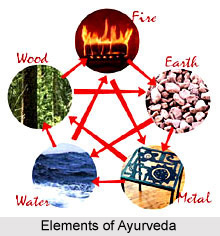 Ayurvedic system is based on the interaction of the body, mind and spirit. In Ayurveda the origin of all aspects of existence is consciousness. Matter and Energy are one. Matter is manifested in five elements i.e. Ether (Space), Air (Vayu), Fire (Agni) , Water and Earth.
Ayurvedic system is based on the interaction of the body, mind and spirit. In Ayurveda the origin of all aspects of existence is consciousness. Matter and Energy are one. Matter is manifested in five elements i.e. Ether (Space), Air (Vayu), Fire (Agni) , Water and Earth.
1. Ether
Ether is present in the cavities of the mouth, lungs, and digestive area. Ether is the space in which everything happens. It is the field that is simultaneously the source of all matter and the space in which it exists. Ether is only the distance, which separates matter. The chief characteristic of ether is sound. Here sound represents the entire range of vibration.
2. Air
Air is present in the movement of muscles beating of the heart, expansion and contraction of the lungs and working of the digestive tract. Air is the gaseous form of matter, which is movable and dynamic. Within the body, air (oxygen) is the basis for all energy transfer reactions. It is a key element necessary for fire to burn. Air is existence without form.
3. Fire
Fire is present in metabolism, body temperature, sight and intellect. Fire is the power to transform solids into liquids, to gas, and back again. In other words, it possesses power to transform the state of any substance. Within our bodies, the fire or energy binds the atoms together. It also converts food to fats and muscle. Fire transforms food into energy. It creates the impulses of nervous reactions, our feelings, and even our thought processes. Fire is considered a form without substance.
4. Water
Water is present in the digestive juices, saliva, and blood. Water characterizes change and represents the liquid state. Water is necessary for the survival of all living things. A large part of the human body is made up of water. Our blood, lymph, and other fluids move between our cells and through our vessels, bringing energy, carrying away wastes, regulating temperature, bringing disease fighters, and carrying hormonal information from one area to another. Water is a substance without stability.
5. Earth
Earth represents the solid state of matter. It manifests stability, permanence, and firmness. In our body, the parts such as bones, teeth, cells, and tissues are manifestations of the earth. Earth is considered a stable substance.





